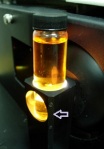 HunterLab offers 3 different sizes of round, molded glass vials that can be useful for volatile samples that require a cap, are heated to high temperatures or are part of an autosampling process.
HunterLab offers 3 different sizes of round, molded glass vials that can be useful for volatile samples that require a cap, are heated to high temperatures or are part of an autosampling process.
The vials come with black polypropylene screw-on caps with a PTFE disc liner to retain volatiles and prevent spills. Use of the vials requires the Transmission Holder for 24-mm ID Round Vial (D02-1011-550) for measuring in TTRAN (preferred) or RTRAN transmission on HunterLab sphere instruments.
- 20 ml Molded Glass Vials (A13-1015-359) – Clear, round 24 mm (0.94 in) ID, molded, borosilicate glass vial with dimensions of 27.25 OD x 57.5 mm high (1.07 in OD x 2.26 in high).
- 40 ml Molded Glass Vials (A13-1015-360) – Clear, round 24 mm (0.94 in) ID, molded, borosilicate glass vial with dimensions of 27.75 OD x 95 mm high (1.09 in OD x 3.74 in high).
- 60 ml Molded Glass Vials (A13-1015-361) – Clear, round 24 mm (0.94 in) ID, molded, borosilicate glass vial with dimensions of 27.5 OD x 140 mm high (1.08 in OD x 5.51 in high).
FAQ: “There are 3 sizes of round glass vials offered by HunterLab – 20 ml, 40 ml and 60 ml. Which size should be used?”
All three (3) cell sizes have the same 24 mm ID/pathlength and fit in the same Transmission Holder but come in three different heights. For successful color measurement with all 3 sizes, the viewed area in the holder must be covered with 20 ml of with liquid sample. The choice of vial height is related to ease of cell handling. In general, the 20 ml (2/3 oz) glass vials are best if sample volume is limited; the 40 ml (1 1/3 oz) glass vials are easier to handle and fill than the 20 ml vials. The transmission door can be closed with both the 20 ml and 40 ml size vials.
The 60 ml size works best for measuring the color of hot solutions, as the extra height allows easy grasping by a set of tongs and there is less heating on the polypropylene caps. The 60 ml vial will stick out of the transmission compartment above the door for exterior venting or external loading if required. The door just has to be drawn closed as far as possible. There is no problem in performance if the door is partially open and the 60 ml cell sticks out through the top.
Further information on measuring the color of hot liquids can be found at our Application Notes page under AN 1030 Hot Liquid Samples.

